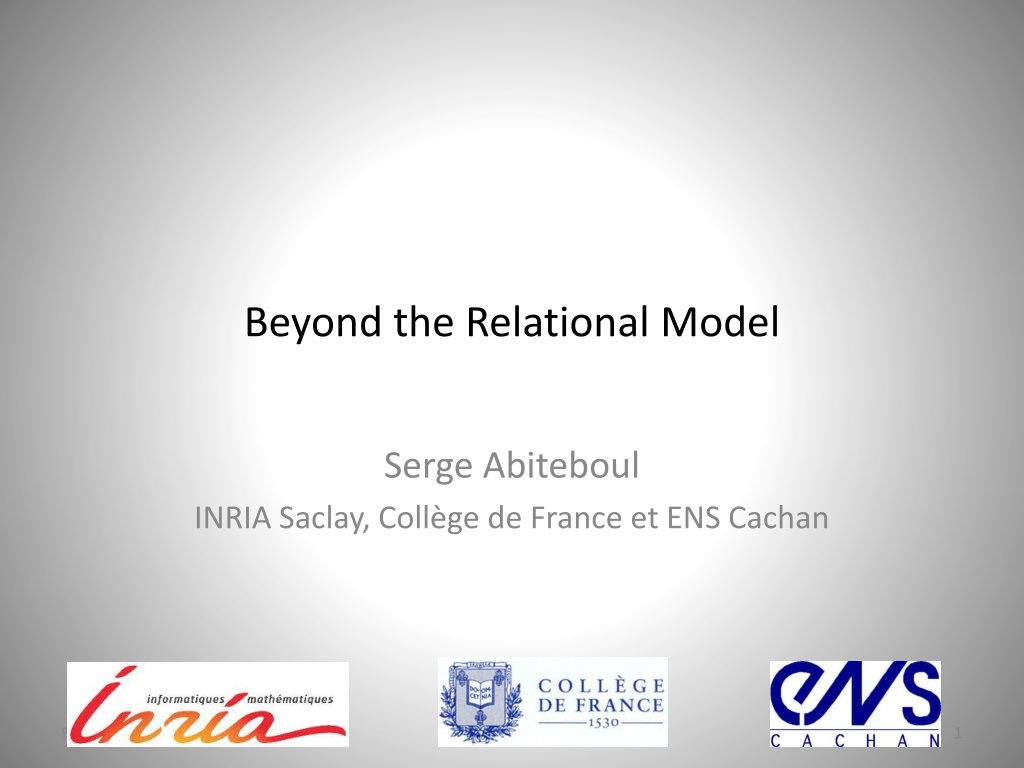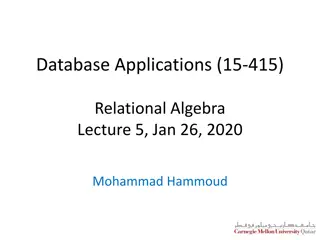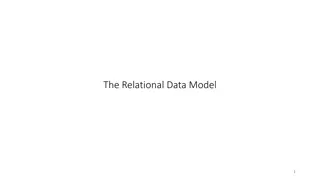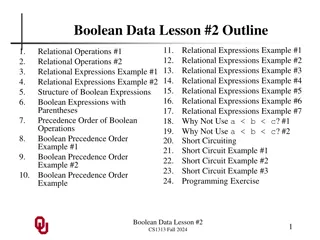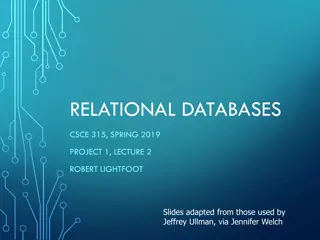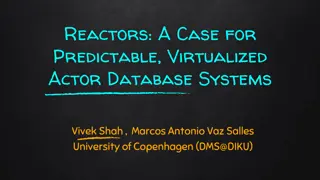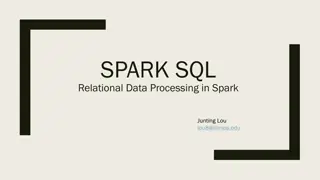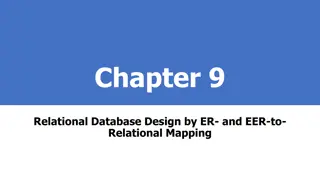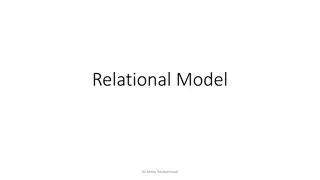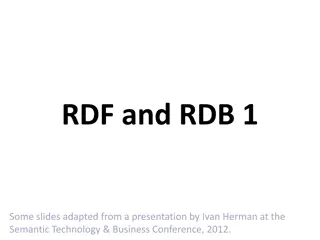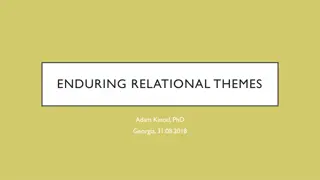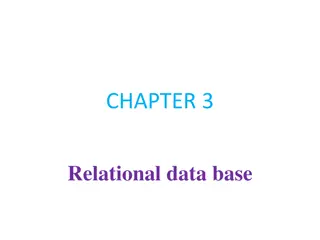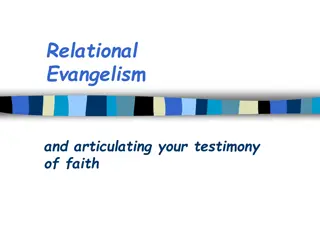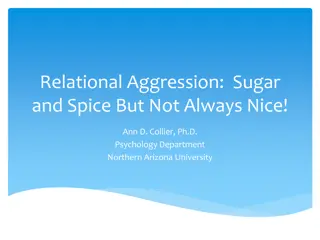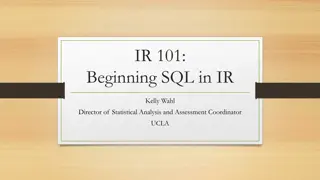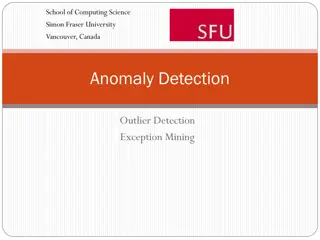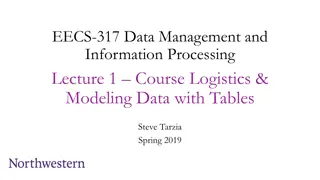Exploring Data Beyond the Relational Model
Serge Abiteboul delves into the world beyond the relational model, challenging established norms in industry and academia, aiming to facilitate application development and enhance performance. The lecture covers topics such as organization trees, XML graphs, object databases, NoSQL, OLAP, and more, emphasizing the significance of going beyond traditional structures like tables and embracing innovative data representation methods.
Download Presentation

Please find below an Image/Link to download the presentation.
The content on the website is provided AS IS for your information and personal use only. It may not be sold, licensed, or shared on other websites without obtaining consent from the author. Download presentation by click this link. If you encounter any issues during the download, it is possible that the publisher has removed the file from their server.
E N D
Presentation Transcript
Beyond the Relational Model Serge Abiteboul INRIA Saclay, Coll ge de France et ENS Cachan 9/16/2024 9/16/2024 9/16/2024 9/16/2024 1 1 1 1
Recall for first lecture: Always question everything In industry: to challenge the well established guys In academia: to discover new problems Revisit the models, languages , principles Main motivations To facilitate application development Performance to scale to always more data and queries To offer more in terms of reliability, security, etc.. We study here some of the main attempts to go beyond the relational model 9/16/2024 2
Organization Trees and XML Graphs and object databases NoSQL OLAP (On-line analytical processing) Conditional tables Next class: Semantic Web 9/16/2024 3
Trees and XML 9/16/2024 4
Introduction Trees are useless n Knowledge lives in trees A tree is a tree. How many more do you have to look at? Ronald Reagan, governor of California, opposing the expansion of Redwood National Park (1966) But of the tree of the knowledge of good and evil, thou shalt not eat of it: for in the day that thou eatest thereof thou shalt surely die. Genesis, 2. 17 We don t need anything beyond relations. These things are useless. Reject! Anonymous referee (circa 1990) The Bible does not say But of the two dimensional table of knowledge of good and evil 9/16/2024 5
Using trees to represent data: an old idea From the 60s and IMS (Hierarchical database model) But fully procedural languages and records at a time All really started in the 80s and Non-first-normal-form Fran ois Bancilhon in France et Hans Schek in Germany PhD thesis of Nicole Bidoit 9/16/2024 6
First-Normal-Form Non-First-Normal-Form N1NF 1NF Name Name Child Child Car Car Alice Alice Toto Toto Lulu Jaguar Jaguar 2CV Alice Lulu 2CV Data at Coll ge de France Bob Bob Mimi Mimi Zaza Mustang Mustang Prius The first class was on relations. Now what? Bob Zaza Prius Data would prefer to live in infamous nested relations aka V-relations aka N1NF relations aka NF2 relations Trees! Data live in 1NF relations: Entries of tables should be atomic 9/16/2024 7
A B The devil is in the details 1 1 1 N1NF- relations V-relations 1 2 A B A C A A B C 1 3 1 1 1 1 1 1 1 2 1 A is not a key The size is now possibly exponential in the size of the domain 1 1 2 1 2 3 3 2 2 2 3 2 2 3 4 3 1 1 3 2 3 3 1 3 3 4 1 2 3 3 1 3 3 1 1 2 3 A is a key No new power 9/16/2024 8
Complex object model: set and tuple constructors Families * Children Children Cars Cars Name Name * * * * Peter Peter Year Year Name Name Name Name Sex Sex Name Sex 1976 2010 Mimi Toto 2CV BMW F M Zaza F 9/16/2024 9
Logic for complex objects Logic: main novelty variables denoting sets Example: AbouBanat query { T.Father | Families(T) X,x ( T.Children = X x X x.Sex = F ) } The father of only girls 9/16/2024 10
Algebra for complex objects Name Child Name Child Set of sets Alice Toto Alice Toto Name Child Bob Mimi Alice Toto Name Child Bob Mimi Name Child Bob Mimi Unnest Nest Unnest Name Child Car Name Name Child Car Child Car Name Child Car Alice Toto Bob Mimi Zaza Lulu Mustang Prius Bob Mimi Mustang Bob Mimi Mustang Bob Mimi Zaza Mustang Bob Zaza Mustang Bob Zaza Mustang Bob Lulu Prius Bob Lulu Prius Bob Lulu Prius 9/16/2024 11 Identity
Results Equivalence theorem: algebra and logic have same expressive power Remark: one can compute transitive closure using algebra/logic (Cool!) Each new level of nesting introduces one more exponential A query is in the algebra/calculus iff it has elementary time complexity (similarly space complexity) 22 2n 9/16/2024 12
From complex objects to semistructured data Families * Children Children Cars Cars Name Name * * * * Peter Peter Year Year Name Name Name Name Sex Sex Name Sex 1976 2010 Mimi Toto 2CV BMW F M Zaza F 9/16/2024 13
Revolution 1: more flexibility Families * Children Children Cars Cars Name Name * * * * Peter Peter Year Year Name Name Name Name Sex Sex Name Sex Annotations 1976 2010 Mimi Toto 2CV BMW F Trash M Zaza F 9/16/2024 14
Revolution 2: get ride of *-nodes and name all nodes Families * Family Family Children Cars Cars Name Name * * * Peter Peter Child Child Car Car Year Year Name Name Name Sex Name Ann. Sex 1976 2010 Toto 2CV BMW M Zaza Trash F 9/16/2024 15
XML = ordered, labeled, unbounded trees Families Family Family Children Cars Cars Name Name Peter Peter Child Child Car Car Year Year Name Name Name Sex Name Ann. Sex 1976 2010 Toto 2CV BMW M Zaza Trash F 9/16/2024 16
This is better adapted to a Web context Self describing data: No separation between schema and data Flexibility Not such a big deal A syntax for inlining and exchanging data <families><family><name>Peter<Name><Cars><Car><Name>BMW</Name ><Year>2010</Year></Car></Cars><Children><Child> The more things change, the more they stay the same 9/16/2024 17
r What else? The trees are unbounded a $ s Like nested relations, trees are unbounded in width Unlike nested relations, they are unbounded in depth One can simulate 2 counter machines with 2 branches I am still looking for a real application that simulate 2 counter machines with XML documents? XML documents are rarely deep But even for bounded trees there are fun questions Rich study of query languages Typing and semantics a b a a a b a a a b a a a a a 9/16/2024 18
What else? the trees are ordered Unranked labeled ordered trees = XML Ignore order Classical optimization Respect order Totally new ball game Reconcile? Order is often painful for optimization 9/16/2024 19
The XML world Typing Tree automata, DTD, XML Schema, Relax NG Query languages XPATH article[1]/auteurs/auteur[2] Xquery FOR $ p IN document ("bib.xml") / / publisher LET $ b: = document ("bib.xml) / / book [publisher = $ p] WHERE count ($ b)> 100 RETURN $ p Monadic datalog, FO, Pebble automata Transformation language: XSLT Other standards around XML SOAP, DOM XML dialects: RSS, WML, SVG, XLink, MathML Lots of open source software 9/16/2024 20
Query containment (continuing jewel of 1stclass) Recall Homomorphism Theorem q1 q2 iff there is a homomorphism from q2 to q1 9/16/2024 21
Tree pattern query semantics Tree pattern query r r r r a b c # b a c b a c c c c c 9/16/2024 22
Tree pattern query semantics Tree pattern query r r r r a b c # b a c # c c c c 9/16/2024 23
Tree pattern query containment Tree pattern containment There is no homomorphism from q2 to q1 r r q 2 q1 # # a b # c c c 24
Tree pattern query containment Tree pattern containment But q1 q2 r r r r q 2 q1 q11 q12 q2 = there is a path of length at least 2 from the root r to a leaf c q1 & the # is not an a There is such a path q1 & the # is not a b There is such a path # # # # a b b # a c c c c c 25
XML storage In a file system A directory is now becoming a searchable database In a native XML DBMS eXist: open source MonetDB In a relational DBMS Blades for storing XML Several types of API XQJ XQuery API for Java specification (XQJ) XML:DB JDBC for XML databases Trend: reduce the separation between DBMS and file systems 9/16/2024 26
Graphs and object databases 9/16/2024 27
Object databases = Object-oriented languages + Databases Object-oriented language Object = data + behavior Objects encapsulate data Standard database features Transactions Queries, etc. Object data model Object identity Complex structure (typically set & tuple constructors) Classes: type and class hierarchies Inheritance 9/16/2024 28
Architecture: relational vs. object Application Application Object cache & cache manager JDBC / ODBC Each reads is to the server Some reads are local Queries or OIDs Relational server Object DB server 9/16/2024 29
The same object from disc to memory Query Navigation In memory object Same object in object database Greatly facilitates developing applications A single data model (richer) Integration with an object programming language, Performance because of complex objects Join between multiple tables replaced by navigation between objects Object often in local cache 9/16/2024 30
Moderate industrial success Object database systems 1989: Object Database Manifesto (Atkinson, Bancilhon et al) Pioneers: O2, ObjectStore, Objectivity, Versant ODMG Standard, OQL Object-Relational Dirty attempts to use relational back-ends to store objects SQL extension In memory objects Relational data with pointers to objects 9/16/2024 31
But the ideas are spreading Standard around Java: JDO Popular open source software such as Db4o Frameworks for languages with persistence: JPA, DataObjects.NET 9/16/2024 32
NoSQL 9/16/2024 33
Motivations for NoSQL DBMSs pay a high overhead for their universality Avoid this overhead for very demanding applications Major overheads to avoid: 1. Buffer Management: cache disk blocks in memory 2. Locking: for the management of concurrency.. Transactions must wait for the release of locks 3. Latching: Short term locks used for access structures that are shared as B- tree 4. Logging: Every update is written in the log that is forced to disk Analysis of OLTP applications [Harizopoulos & AL08]: 35% buffer management 19% latching 21% locking 17% logging 9/16/2024 34
Specialized data management systems Specialized for certain types of queries Specialized for certain aspects such as scalability In return: sacrifice universality Sacrifice certain types of queries like the join Sacrifice some features, such as concurrency No SQL Non-standard systems for data management Typically simpler data models (Support sometimes SQL) Warning: the term NoSQL is also used sometimes for systems based on the contrary, more complex models: Object /XML / RDF not here 9/16/2024 35
NoSQL : different flavors Extreme performance Massive scalability Massive distribution Total availability Specialization High transaction rates Simple OLAP queries on very large volumes No universality Less independence No 3 levels Less abstraction Not relational and SQL Simple Data: key / value Simple queries Loss of functionality No ACID (strict) Less typing and integrity Simple access structures simplistic API - no JDBC 9/16/2024 36
Examples Key / value store with weak consistency Cassandra (Apache), Dynamo (Amazon) Key / value store on disk Hadoop Hbase (Apache), BigTable (Google) Document store with N1NF MongoDB (free software) Main memory database single-threaded for OLTP VolTDB Massively parallel database for analysis Greenplum, MySQL Cluster And many more 9/16/2024 37
The OLAP multidimensional model 9/16/2024 38
Data get organized in cubes USA Canada Canada Canada France France France UK USA UK March 12 25 14 86 Bread Bread Pain USA UK February 12 25 14 86 January 23 68 45 25 Cheese Cheese Fromage 12 25 14 86 23 68 45 25 12 95 65 42 Yoghurt Yoghurt Yaourt 23 68 45 25 12 95 65 42 44 22 33 18 Chocolate Chocolate Chocolat 12 95 65 42 44 22 33 18 44 22 33 18 Region + more dimensions: Kind of customer Kind of sale (web, Product 9/16/2024 39
Discussion Ted Codd 1995 Evolution from spreadsheet Provide multidimensional views for analysis Hierarchical domains Time: day, week, month, year Aggregation Example of queries 5 top demography groups buying videos Products sold in France where rejection rate diminished by more than 5% Querying, navigation, reporting 9/16/2024 40
Standard query language: MDX (MSFT, 1997) SQL MDX select, from, where, group-by Yields a table (2-dim) Select columns from some tables Filter lines with predicates in where clause Aggregation using group by with, select, from, where Yields a cube (N-dim) Select: select cube dimensions With: specification on selected dimensions Where: specification on non selected dimensions Implicit aggregation with member Measures.profit as Measures.StoreSales Measures.cost select {Measures.StoreSales, Measures.Profit} on columns, non empty filter(Product.ProductDepartment.members, (Product.currentMember, Measures.StoreSales) > 20000.0) on rows from [Sales] where ([Time].[1997]) 9/16/2024 41
Conditional tables 9/16/2024 42
Uncertainty Lots of uncertain data Studied in academia Not much in industry Null values in SQL Trash semantics No clear standard We will see here in brief Conditional tables How to turn them probabilistic 9/16/2024 43
Conditional tables & uncertainty Friend Location Condition Alice London E E F Bob London Alice Paris E Lucile London F Friend Location Friend Location Friend Location Friend Location Alice London Alice London Alice Paris Alice Paris Bob London Lucile London Lucile London 4 possible worlds 9/16/2024 44
Conditional tables & probabilities Friend Location Condition E is 80% F is 40% Alice London E E F Bob London Alice Paris E Lucile London F Friend Location Friend Location Friend Location Friend Location Alice London Alice London Alice Paris Alice Paris Bob London Lucile London Lucile London 32% 48% 8% 12% 9/16/2024 45
A jewel of databases The worst way I know of computing transitive closure 9/16/2024 46
Calculus for complex objects The points reachable from a in a graph G { x R ( ( R(a) y,z ( R(y) G(y,z) R(z) ) ) R(x) ) } x is reachable from a if x R for each set R containing a and closed under G 9/16/2024 47
Algebra for complex objects The points reachable from a in a graph G D := ?1(G) ?2(G): the nodes in G P := 2D an algebraic query (in classical relational algebra) equivalent to: R(a) x,y ( R(x) G(x,y) R(y) ) Q := (P) : the subsets of D satisfying Q := ?1( 1 2(Q Q)) : the non-minimal elements in Q Q := Q Q : the minimal elements in Q (unique) unnest(Q ) : the points reachable from a in G : the powerset of D 9/16/2024 48
Complexity Quantify Over Sets of sets of sets Quantify Over Sets of sets + FP 2exptime Quantify Over Sets of sets Quantify Over Sets + FP exptime Quantify Over Sets Calculus + order + FP ptime calculus 9/16/2024 49
Conclusion 9/16/2024 50
